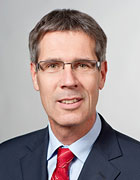
Prof. Dr. Thomas Horstmann
Kontakt
Wissenschaftliche Laufbahn und Forschungsgebiete
Prof. Horstmann (*1961) forscht auf dem Gebiet der konservativen und rehabilitativen Orthopädie mit der Zielsetzung orthopädische Pathologien frühzeitig zu erkennen, ihre präoperative Versorgung zu verbessern und die postoperative Rückkehr der Patienten in den Alltag zu beschleunigen.
Prof. Horstmann studierte an der Universität Freiburg Humanmedizin und im Zweitfach Sportwissenschaft und promovierte (1987) in Freiburg. Seine Habilitation (1999) absolvierte er an der Universitätsklinik Tübingen, wo er als ärztlicher Leiter der Sportorthopädie vorstand. Seit 2008 ist Prof. Horstmann Chefarzt der Medical Park Klinik St. Hubertus Bad Wiessee. Er ist Mitglied in nationalen und internationalen wissenschaftlichen Gesellschaften (American College of Sports Medicine, Deutsche Gesellschaft für Sportmedizin und Prävention e.V., Deutsche Gesellschaft für manuelle Medizin e.V., Gesellschaft für orthopädisch traumatologische Sportmedizin, Verband leitender Orthopäden und Unfallchirurgen).
Schlüsselpublikationen (alle Publikationen)
Horstmann T, Heitkamp HC, Haupt G, Merk J, Mayer F, Dickhuth HH: „Möglichkeiten und Grenzen der Sporttherapie bei Coxarthrose- und Hüftendoprothesen-Patienten“. Dt Z Sportmed 2001; 52: S. 274 - 278.
AbstractHorstmann T, Mayer F, Maschmann J, Niess A, Roecker K, Dickhuth HH: “Metabolic reaction following concentric and eccentric endurance-exercise of the knee and ankle”. Med Sci Sports Exerc 2001; 33: S. 791 - 795.
AbstractGrau S, Maiwald C, Krauss I, Axmann D, Best R, Horstmann, T: “What are Causes and Treatment Strategies for patellar-tendinopathy in female runners?” J. Biomech. 2008; 41(9): S. 2042 - 2046.
AbstractBoeer J, Mueller O, Krauss I, Haupt G, Axmann D, Horstmann T: “Effects of a sensory-motor exercise program for older adults with osteoarthritis or prosthesis of the hip using measurements made by the Posturomed oscillatory platform”. J. Geriatic Phys. Ther. 2010; 33 (1): S. 10 - 15.
AbstractKrauss I., Grau S., Maiwald C., Mauch M., Horstmann T: “Sex-related differences in foot shape of adult Caucasian – a follow-up study focussing on long and short feet”. Ergonomics 2011; 54 (3): S. 294 - 300.
AbstractBei Änderungs- oder Aktualisierungswünschen wenden Sie sich bitte an Franz Langer.